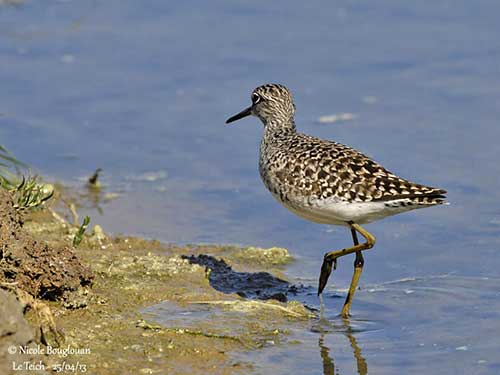
Fr: Chevalier sylvain
Ang: Wood Sandpiper
All: Bruchwasserläufer
Esp: Andarríos Bastardo
Ita: Piro-piro boschereccio
Nd: Bosruiter
Sd: Grönbena
Photographers:
John Anderson
John Anderson Photo Galleries
Didier Buysse
Vision d’Oiseaux
Otto Plantema
Trips around the world
Ingo Waschkies
Bird Photography
Nicole Bouglouan
PHOTOGRAPHIC RAMBLE
Text by Nicole Bouglouan
Sources :
HANDBOOK OF THE BIRDS OF THE WORLD Vol 3 by Josep del Hoyo-Andrew Elliott-Jordi Sargatal - Lynx Edicions - ISBN : 8487334202
SHOREBIRDS by Peter Hayman, John Marchant and Tony Prater – Christopher Helm – 1986 – ISBN: 0747014035
THE COMPLETE BOOK OF BRITISH BIRDS – Written by “Royal Society for the Protection of Birds” experts - Préface de Magnus Magnusson - Michael Cady- Rob Hume Editors - ISBN: 0749509112
GUIDE DES LIMICOLES de D. Taylor - Delachaux et Niestlé - ISBN : 2603014080
ENCYCLOPEDIE DES OISEAUX DE FRANCE ET D’EUROPE – de Peter Hayman et Rob Hume - Flammarion – ISBN : 2082009920
THE HANDBOOK OF BIRD IDENTIFICATION FOR EUROPE AND THE WESTERN PALEARCTIC by Mark Beaman, Steve Madge - C.Helm - ISBN: 0713639601
Birds in backyards (Birds Australia and Australian Museum)
Biodiversity Explorer – The Web of Life in Southern Africa
What Bird-The ultimate Bird Guide (Mitchell Waite)
Department of Sustainability, Environment, Water, Population and Communities
History of the Wood Sandpiper as a breeding bird in Britain by Kenna Chisholm
Wood Sandpiper
Tringa glareola
Charadriiformes Order – Scolopacidae Family
INTRODUCTION:
The Wood Sandpiper is one of the strongest migrant species within the genus Tringa. It is typically found on inland waters such as freshwater marshes, ricefields, flooded grasslands, but it usually avoids estuaries’ flats and coasts.
This species breeds in subarctic wetlands and winters in Africa, S Asia (India) and Australia.
It is the smallest wader of this genus.
DESCRIPTION OF THE BIRD:
Biometrics:
Length: 19-23 cm
Wingspan: 34-37 cm
Weight: 34-98 g
The Wood Sandpiper adult in breeding plumage has blackish-brown upperparts, strongly barred and spotted pale grey-brown and white. Rump and uppertail-coverts are white. Rectrices are pale brown and narrowly barred white.
On the underparts, chin and throat are white. Breast and neck are streaked and spotted dark brown, fading into the whitish rest of underparts. The upper flank is strongly barred brown. The underwing is white, slightly barred greyish-brown.

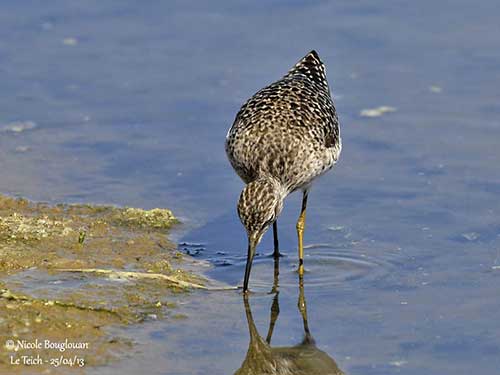
On the head, the crown is blackish-brown with whitish streaks. The hindneck is paler. There is a conspicuous, long, white supercilium extending from bill to ear-coverts.
The straight bill is about 23-32 millimetres long. It has olive-green or yellow-green base and blackish tip. The eyes are dark brown, surrounded by narrow, white eyering. Legs and feet are dull yellow, often greenish to brownish-yellow.
In non-breeding plumage, the upperparts are mostly grey-brown with whitish spots. The breast is grey-brown with indistinct brown streaks. Barring on flanks is absent.
The female resembles male but she is slightly larger.
The juvenile has dark brown upperparts heavily spotted and fringed buff-brown. The breast is washed grey-brown and finely streaked brown.
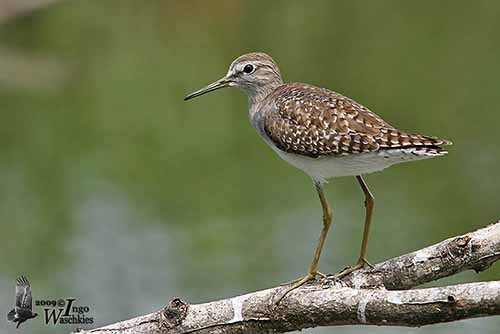
RANGE:
The Wood Sandpiper breeds in N and C Europe through Siberia to Anadyr land, Kamchatka and Commander Islands, and NE China. It is occasionally seen in Aleutian Islands in spring.
It winters in tropical and subtropical Africa, and across S and SE Asia to S China, Philippines, Indonesia, New Guinea and Australia. Some occasional individuals have been recorded as far north as Britain.
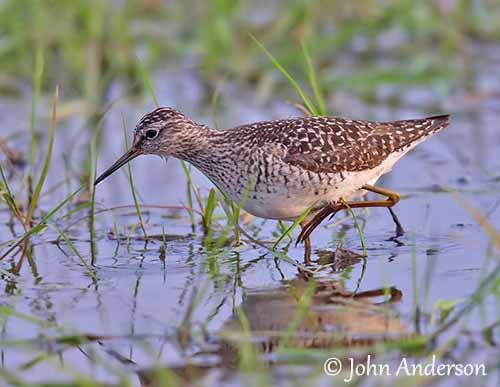
HABITAT:
The Wood Sandpiper breeds in damp, open parts of boreal forests, in marshes with deciduous scrub, in wet heathlands with scattered trees, and between tundra and coniferous forests. It rarely nests away from trees or in alpine zone.
Outside the breeding season, it can be found on inland freshwaters and marshes, occasionally near temporary pools. It rarely frequents intertidal habitats such as salt-marshes and mangrove swamps.

CALLS AND SONGS: SOUNDS BY XENO-CANTO
The Wood Sandpiper in flight gives nervous, high-pitched calls “chiff-iff-iff”. The alarm call is a sharp “chip” usually rapidly repeated.
It utters a yodelling song in display flight (rarely from perch), a musical, repeated “leeltee-leeltee-leeltee…” reminiscent of Common Redshank’s song but higher-pitched.
BEHAVIOUR IN THE WILD:
The Wood Sandpiper feeds on small aquatic preys including insects such as beetles, Hemiptera and larvae of Diptera, taken mainly during the breeding season.
In all seasons, it takes aquatic and terrestrial insects and their larvae, but also worms, spiders, small crustaceans, molluscs, small fish of up to 2 centimetres long, tadpoles and occasionally frogs. It may consume some seeds sometimes.
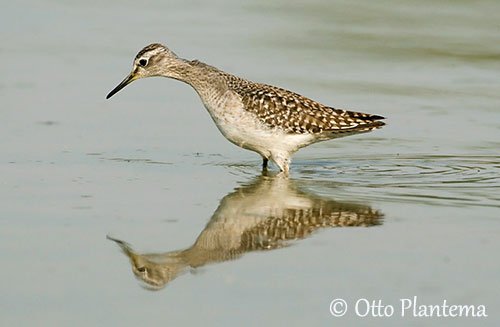
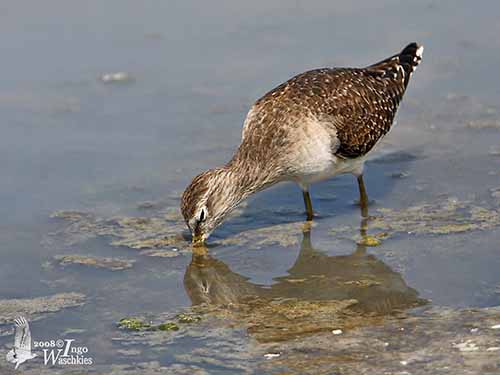
It forages singly, in pairs or in scattered groups in open marshes. It walks slowly in shallow water or mud, gleaning, probing or sweeping with the bill through the water. It also catches flying insects from the air. It may occasionally swim.
The Wood Sandpiper is a wary and nervous bird. When alarmed, it bobs the head like numerous Tringa species. It flushes easily and calls while rising high.
During the breeding season, it performs aerial displays accompanied by song. The bird rises into the air and circles before to perform an undulating flight with rapid wingbeats, interspersed with glides on arched, stiff wings, fanned tail and dangling legs. It sings during the descendant glide. This species is monogamous.
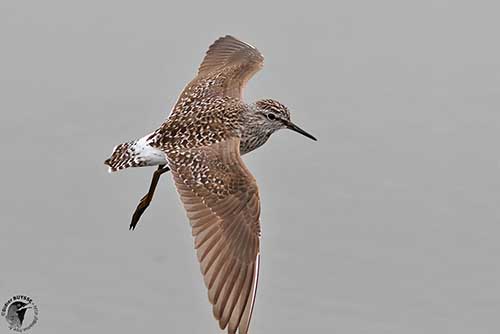
The Wood Sandpiper is migratory and moves S to winter. They migrate across Europe and Middle East overland on broad front, usually S-SSW. Many stopovers occur in Mediterranean (Camargue in France, and Italy), before to overfly the Sahara in SW direction to W Africa.
The Siberian breeders winter in India and SE Asia, with a few continuing to Australia.
The Wood Sandpiper has swaying flight with rapid wingbeats. It rises very high and at great speed when flushed, and flies for considerable distance before dropping.
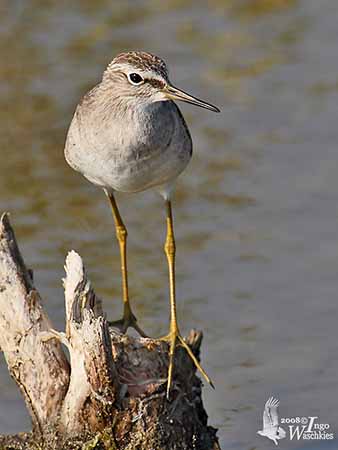
REPRODUCTION OF THIS SPECIES:
The Wood Sandpiper breeds in spring with the laying between May and mid-July. Is nests solitary with about 1-10 pairs/km². However, in forested tundra, groups of 50 birds/km² are fairly common.
The nest is a shallow scrape among dense ground cover, lined with moss, leaves and other plant material. It nests often in trees too, and uses nests abandoned by other bird species.

The female lays 3-4 pale olive-green eggs with dark markings. Both adults share the incubation during 22-23 days. At hatching, the chicks have pale buff to whitish down with darker markings on the upper back, white underparts and dark head. Both parents rear them together for 7-10 days, but the last days, only the male cares them. The young fledge about one month after hatching.
This species produces a single brood per year.
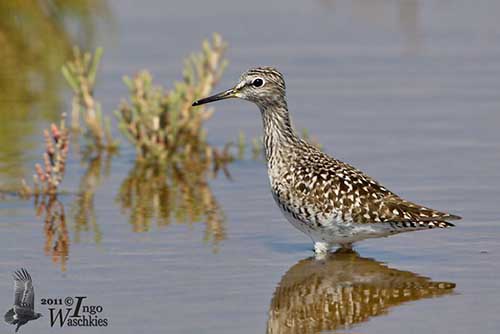
PROTECTION / THREATS / STATUS:
The Wood Sandpiper has very wide range where it is sometimes threatened by exploitation, drainage and destruction of wetlands for forestry and agriculture, especially in Finland. Climatic changes may affect this species too, and declines are reported in S Sweden, Germany and Poland.
The global population was estimated to number 3,100,000/3,600,000 individuals in 2006, and this population is suspected to be stable.
The Wood Sandpiper is currently evaluated as Least Concern.
